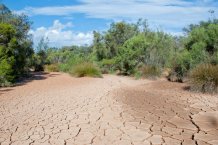Articles

During droughts, plants reduce photosynthesis (image: Colourbox)
Drought increases CO2 concentration in the air
The concentration of carbon dioxide in the atmosphere rises faster during drier years because struggling ecosystems absorb less carbon, new research shows.
The study – led by Vincent Humphrey at ETH Zurich and supported by the University of Exeter and the Laboratoire des Sciences du Climat et de l'Environnement (France) – used innovative satellite technology to measure the global sensitivity of ecosystems to water stress (lack of water).
They found that during the driest years such as 2015, natural ecosystems removed about 30% percent less carbon from the atmosphere than during a normal year.
As a result, the concentration of CO2 in the atmosphere increased faster in 2015 than in normal years. Meanwhile, during the wettest year on record in 2011, CO2 concentrations increased at a much slower rate due to healthy vegetation.
Land ecosystems absorb on average 30% of CO2 emissions caused by humans, thereby tempering the increase of CO2 concentration in the atmosphere.
During droughts, plants reduce photosynthesis and capture less carbon dioxide from the surrounding air.
While this effect can be easily observed in the lab, measuring its impact on the whole planet has proved difficult.
Conventional satellites only see what happens at the surface and cannot measure how much water is available underground.
But in the last few years, a new type of satellite mission has been used to measure extremely small changes in the Earth’s gravity field.
It was found that some small perturbations of the gravity field are caused by changes in water storage.
When there is a major drought in a given region, there is less water mass and gravity is consequently slightly weaker over that region.
By measuring this with satellites, scientists are able to estimate large-scale changes in water storage to an accuracy of about four centimetres everywhere on the planet.
The researchers in this study compared year-to-year changes in total water mass over all continents against global measurements of CO2 increase in the atmosphere.
These results help us understand why atmospheric CO2 growth can vary a lot from one year to the other, even though CO2 emissions from human activities are comparatively stable.
“This study crucially demonstrates a strong link between changes in terrestrial water and the global carbon cycle,” said Professor Stephen Sitch, Chair in Climate Change at the University of Exeter.
“Given we can now monitor changes in the terrestrial water from space this opens up new and exciting avenues in climate-carbon cycle research.”
During the last century, the concentration of CO2 in the atmosphere has been steadily increasing because of human activities.
“Now that most countries around the world have agreed they should limit CO2 emissions, we are facing the challenge of monitoring CO2 fluxes to a level of accuracy higher than ever before,” said Vincent Humphrey.
The paper, published in Nature, is entitled: “Sensitivity of atmospheric CO2 growth rate to observed changes in terrestrial water storage.”
Date: 29 August 2018
